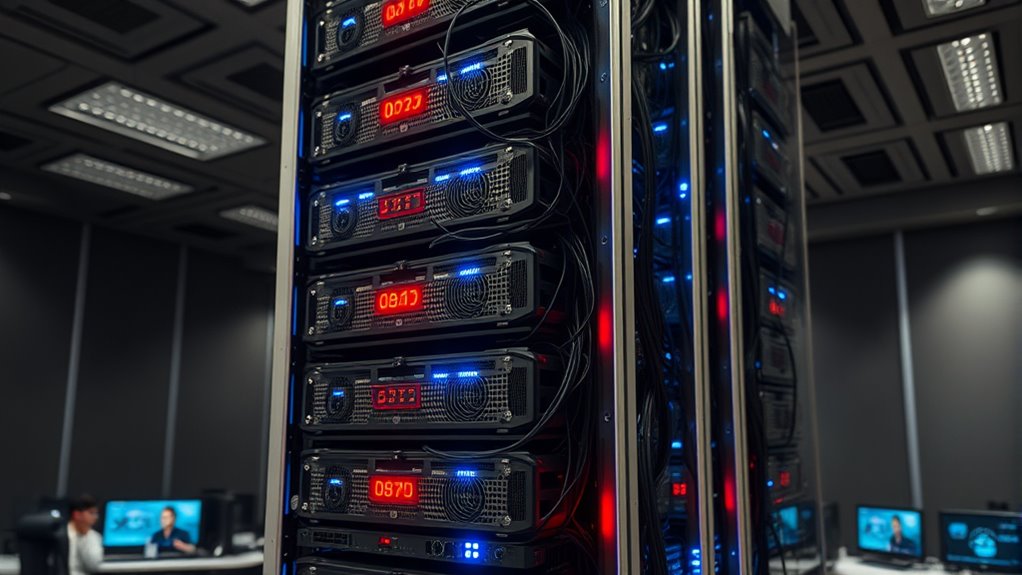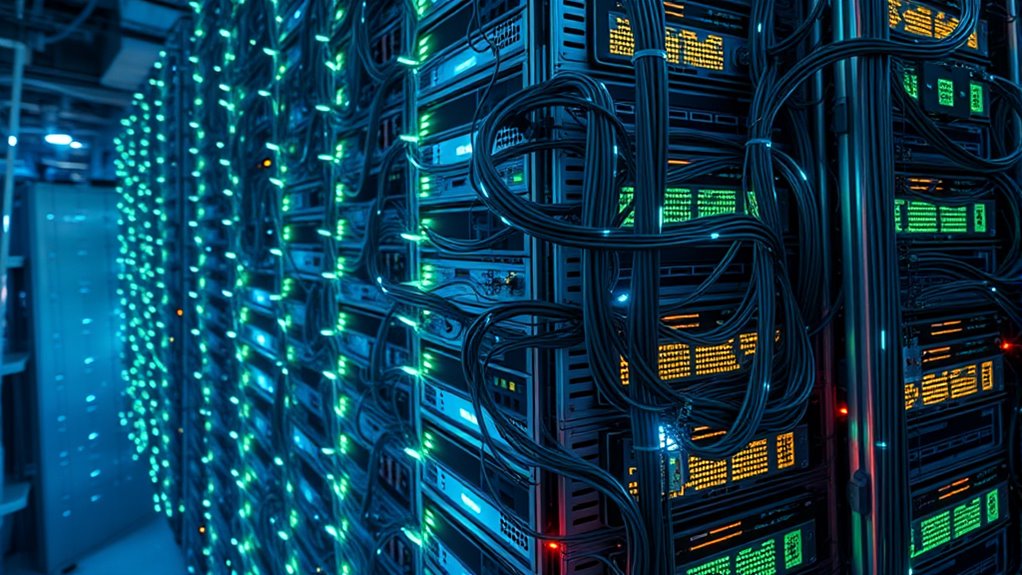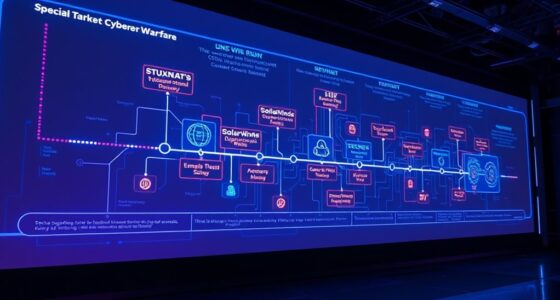The surveillance stack has evolved through key milestones: from bulky CCTV cameras to advanced, miniature, high-definition devices that transmit data globally. Digital transformation allowed easier storage and analytics, while integration of sensors, drones, and biometric tools created all-encompassing security ecosystems. Today, AI and machine learning enable systems to detect threats, analyze patterns, and respond proactively. As you explore further, you’ll uncover how these innovations continue to shape the future of security technology.
Key Takeaways
- Introduction of bulky CCTV cameras in the mid-20th century laid the foundation for modern surveillance.
- Miniaturization and high-definition capabilities advanced camera technology for discreet, detailed monitoring.
- Transition from analog to digital systems enabled efficient storage, retrieval, and analytics of surveillance footage.
- Integration of diverse sensors, biometrics, and drones created comprehensive, interconnected security ecosystems.
- AI and machine learning transformed surveillance into intelligent, adaptive systems capable of pattern recognition and threat prediction.

Have you ever wondered how surveillance technology has evolved over the years? It’s a story of constant innovation, driven by the need for better security, control, and information gathering. The journey began with basic methods like closed-circuit television (CCTV) cameras, which first appeared in the mid-20th century. These early systems were bulky and limited, but they laid the groundwork for modern video surveillance. As technology advanced, cameras became smaller, more affordable, and capable of transmitting high-definition footage. Today, you can find cameras that are almost invisible, yet capable of zooming in on minute details, providing real-time monitoring from anywhere in the world.
Surveillance has evolved from bulky CCTV cameras to sleek, high-definition, real-time monitoring devices worldwide.
The next milestone was the integration of digital technology. Instead of relying solely on analog signals, surveillance systems shifted to digital networks, allowing for easier storage, retrieval, and analysis of footage. This shift meant that entire surveillance archives could be stored on servers or cloud platforms, making it possible to access countless hours of footage instantly. It also introduced the possibility of sophisticated analytics, like facial recognition and motion detection, which greatly enhanced the efficiency of security operations. You might not realize it, but many systems you see today automatically flag unusual activity or identify known individuals, thanks to these advancements.
Another key milestone was the development of networked and interconnected systems. No longer confined to isolated cameras, modern surveillance stacks are part of complex ecosystems that include sensors, biometric scanners, drones, and even AI-driven analytics. These interconnected systems enable thorough, layered security approaches. For you, this means a seamless experience—security personnel can monitor multiple feeds, analyze data across different sources, and respond swiftly to threats or incidents. It’s a shift from reactive to proactive security, where potential issues are identified and addressed before they escalate.
The introduction of artificial intelligence and machine learning has further revolutionized surveillance. These technologies allow systems to automatically interpret vast amounts of data, recognize patterns, and predict future behavior. With AI, surveillance becomes smarter—capable of identifying suspicious activities, tracking individuals across different cameras, and even predicting crowd movements. As a user, you benefit from enhanced safety and security, with fewer false alarms and faster responses. This evolution has transformed surveillance from simple observation tools into intelligent, adaptive systems that continuously learn and improve.
From basic cameras to AI-powered, interconnected networks, each milestone in the surveillance stack has drastically changed what’s possible. These innovations have expanded your ability to monitor, analyze, and respond to security needs, shaping a world where surveillance is more integrated, efficient, and, in many cases, more intrusive than ever before. Moreover, advancements in high-resolution imaging have further refined the clarity and detail of surveillance footage, making it even easier to identify individuals and objects in complex environments.
Frequently Asked Questions
How Does the Surveillance Stack Impact Individual Privacy Rights?
The surveillance stack can markedly impact your privacy rights by enabling extensive monitoring of your activities, communications, and location data. As technology advances, you might find your personal information collected, analyzed, and potentially shared without your consent. This can lead to a loss of control over your private life, increased risk of data breaches, and a sense of constant surveillance, making it harder to maintain personal boundaries and freedoms.
What Are the Key Technological Innovations Behind Surveillance Milestones?
You see, the key innovations behind surveillance milestones include advanced facial recognition, which allows quick identification in crowds, and deep learning algorithms that analyze vast data streams effortlessly. Networked sensors and data aggregation tools also play crucial roles, enabling continuous monitoring and pattern detection. These technologies work together seamlessly, transforming raw data into powerful insights, subtly enhancing monitoring capabilities and reshaping how information is gathered and utilized.
Who Are the Major Stakeholders Involved in Developing the Surveillance Stack?
You work with government agencies, private corporations, and technology developers who all play crucial roles in creating the surveillance stack. Governments fund and regulate, shaping policies and deploying systems. Tech companies design and build the hardware and software that make surveillance possible. Citizens, often unknowingly, become data sources. Collaboration and competition among these stakeholders drive innovation, raising ethical questions and impacting privacy rights as they develop and refine surveillance technologies.
How Do International Laws Influence Surveillance Technology Deployment?
Did you know that over 60% of countries have implemented laws regulating surveillance technology? International laws profoundly influence deployment by setting standards for privacy, data protection, and human rights. You must navigate these legal frameworks to guarantee compliance, avoid sanctions, and protect individual freedoms. These laws shape how surveillance tools are used, restricting or enabling their deployment across borders, and emphasizing accountability and transparency in surveillance practices worldwide.
What Future Trends Are Expected to Shape the Surveillance Stack?
You can expect future surveillance trends to focus on increased AI integration, enabling faster and more accurate data analysis. Privacy concerns will push for advanced encryption and anonymization techniques, while governments and corporations will deploy more IoT devices for real-time monitoring. You might also see the rise of decentralized surveillance systems, giving you greater control over your data. Overall, technology will become more sophisticated, but so will efforts to protect individual privacy.
Conclusion
As you’ve seen, the surveillance stack has evolved like a river carving its path through time, shaping the landscape of privacy and security. These milestones highlight how technology continually pushes boundaries, often leaving us to navigate the currents of progress and concern. Staying aware of these changes helps you understand the power dynamics at play. Remember, in this ongoing journey, you’re not just a bystander—you’re part of the flow shaping the future of surveillance.









